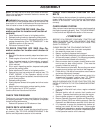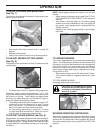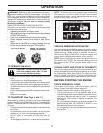
6
ASSEMBLY
NOTE: You may now roll or drive your tractor off the skid.
Follow the ap propriate instruction below to remove the
tractor from the skid.
WARNING: Before start ing, read, un derstand and fol low
all in structions in the Op eration section of this man ual. Be
sure tractor is in a well-ventilated area. Be sure the area in
front of tractor is clear of other peo ple and objects.
TO ROLL TRACTOR OFF SKID (See Op-
eration section for location and function of
controls)
1. Raise attachment lift lever to its highest po sition.
2. Release parking brake by de pressing brake ped al.
3. Place freewheel control in dis engaged po sition to dis-
engage trans mission (See “TO TRANS PORT” in the
Operation section of this manual).
4. Roll tractor forward off skid.
TO DRIVE TRAC TOR OFF SKID (See Op-
eration section for location and function of
controls)
1. Be sure all the above assembly steps have been com-
pleted.
2. Check engine oil level and fill fuel tank with gasoline.
3. Place freewheel control in "trans mission engaged"
position (see "TO TRANSPORT" in Operation section
of this manual).
4. Sit on seat in operating position, depress brake pedal
and set the parking brake.
5. Raise attachment lift lever to its highest position.
6. Remove key from bag and start the engine (see "TO
START ENGINE" in the Operation section of this
manual). After engine has started, move throttle control
to idle (slow) position.
7. Release parking brake.
8. Slowly depress forward drive pedal and drive tractor
off skid.
9. Apply brake to stop tractor and set park ing brake.
10. Turn ignition key to "STOP" position.
Continue with the in structions that follow.
CHECK TIRE PRESSURE
The tires on your tractor were overinflated at the factory
for shipping purposes. Correct tire pressure is important
for best cutting performance.
• Reduce tire pressure to PSI shown on tires.
CHECK DECK LEVELNESS
For best cutting results, mower housing should be prop-
erly leveled. See “TO LEVEL MOWER HOUSING” in the
Service and Adjustments section of this manual.
✓CHECKLIST
BEFORE YOU OPERATE YOUR NEW TRAC TOR, WE
WISH TO ASSURE THAT YOU RECEIVE THE BEST
PERFORMANCE AND SATISFACTION FROM THIS
QUALITY PRODUCT.
PLEASE REVIEW THE FOLLOWING CHECKLIST:
✓ All assembly instructions have been com pleted.
✓ No remaining loose parts in carton.
✓ Battery is properly prepared and charged.
✓ Seat is adjusted comfortably and tightened securely.
✓ All tires are properly inflated. (For shipping purposes,
the tires were overinflated at the factory).
✓ Be sure mower deck is properly leveled side-to-side/
front-to-rear for best cutting results. (Tires must be
properly inflated for leveling).
✓ Check mower and drive belts. Be sure they are routed
properly around pulleys and inside all belt keepers.
✓ Check wiring. See that all connections are still secure
and wires are properly clamped.
✓ Before driving tractor, be sure free wheel control is in
“transmission engaged” position (see “TO TRANS-
PORT” in the Operation section of this man ual).
WHILE LEARNING HOW TO USE YOUR TRACTOR, PAY
EXTRA ATTENTION TO THE FOLLOWING IMPORTANT
ITEMS:
✓ Engine oil is at proper level.
✓ Fuel tank is filled with fresh, clean, regular unleaded
gasoline.
✓ Become familiar with all controls, their location and
function. Operate them before you start the engine.
✓ Be sure brake system is in safe operating condition.
✓ Be sure Operator Presence System and Reverse Op-
eration System (ROS) are working properly (See the
Operation and Maintenance sections in this manual).
✓ It is important to purge the transmission before op-
erating your tractor for the first time. Follow proper
starting and transmission purging instructions (See
“TO START EN GINE” and “PURGE TRANSMISSION”
in the Op eration section of this manual).
CHECK FOR PROPER POSITION OF ALL
BELTS
See the figures that are shown for replacing motion and
mower blade drive belts in the Service and Adjustments
section of this manual. Verify that the belts are routed
correctly.
CHECK BRAKE SYSTEM
After you learn how to operate your tractor, check to see that
the brake is operating properly. See “TO CHECK BRAKE”
in the Service and Adjustments section of this manual.


















